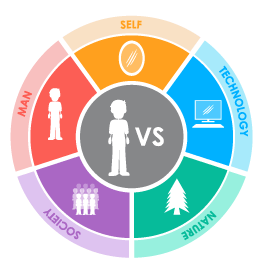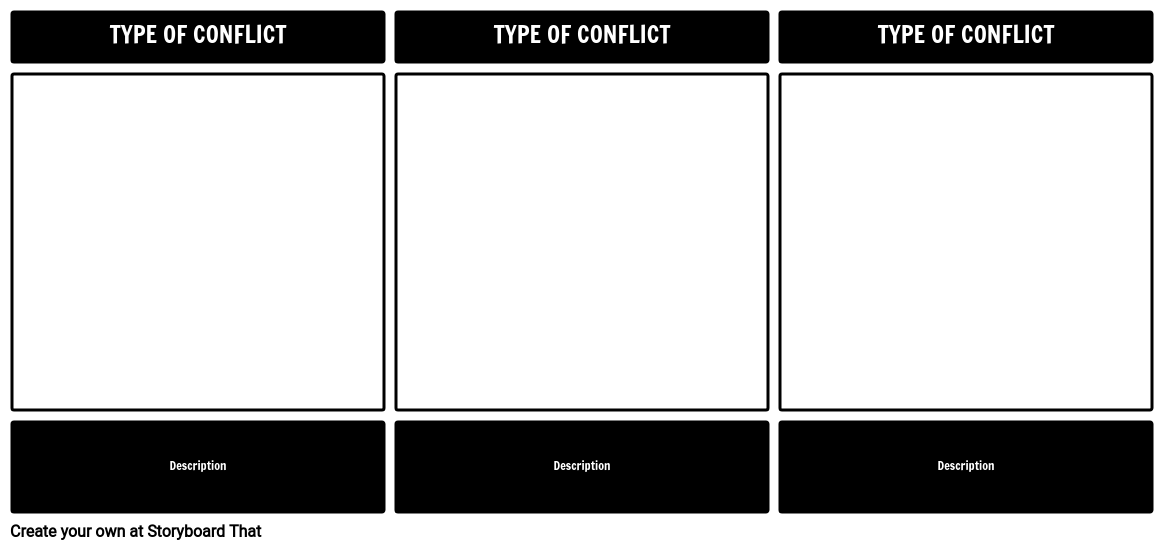Activity Overview
Storyboarding is an excellent way to focus on types of literary conflict. Have your students choose an example of each literary conflict and depict them using the Storyboard Creator.
In the storyboard, an example of each conflict should be visually represented, along with an explanation of the scene, and how it fits the particular category of conflict.
Literary Conflict Examples
MAN vs. MAN
When Cliff Quackenbush mocks Gene and then calls him “maimed”, it hits too close to home and Gene loses it. He punches Quackenbush in the face and they fall into the river. Gene says this is the first of many battles he fights for Finny, as Finny has now become what is seen as “maimed.”
MAN vs. SELF
Gene struggles with internal conflict. Gene’s guilt about what he’s done to Finny leads him to try to make it up to him. When Finny returns to Devon, he declares that Gene will train for the 1944 Olympics in his place. Gene is happy to do something tangible to try to make up for hurting Finny physically, and hurting him in his confession to him in Boston.
MAN vs. SOCIETY
Leper goes against the constructs of society by losing his mind and going AWOL from the Army. He is unable to deal with the demands of training, which is something that is expected of all men during this time of war in the 1940s. He is also not expected to desert his post and flee to his parents’ house, which is considered both illegal, and dishonorable.
Template and Class Instructions
(These instructions are completely customizable. After clicking "Copy Activity", update the instructions on the Edit Tab of the assignment.)
Student Instructions
Create a storyboard that shows at least three forms of literary conflict in A Separate Peace.
- Identify conflicts in A Separate Peace.
- Categorize each conflict as Character vs. Character, Character vs. Self, Character vs. Society, Character vs. Nature, or Character vs. Technology.
- Illustrate conflicts in the cells, using characters from the story.
- Write a short description of the conflict below the cell.
Lesson Plan Reference
Rubric
(You can also create your own on Quick Rubric.)
| Proficient | Emerging | Beginning | Try Again | |
|---|---|---|---|---|
| Conflict Identification | Student identifies correct major conflicts and uses strong, clear textual evidence to support choice. | Student identifies correct major conflict and uses few or unclear details to support their choice. | Student identifies incorrect major conflict, and uses some details from the text to support their choice. | Student does not attempt to identify major conflict or identifies incorrect major conflict with no explanation. |
| Understanding Outcome | Student clearly shows the outcome of the conflict and its effects on the protagonist with evidence from the text. | Student shows the outcome of the conflict and its effect on the protagonist, but some evidence is unclear. | Student shows the outcome of the conflict, but does not examine its effect on the protagonist and uses some vague textual evidence. | Student does not clearly show the outcome of the conflict or use textual evidence. |
| Character | Storyboard includes all required characters and clearly names them. Goes above and beyond by adding additional details. | Storyboard includes all required characters and clearly names them. | Storyboard includes protagonist and antagonist but leaves out other required characters. | Storyboard does not include the names of required characters. |
| Storyboard | Student clearly shows effort to convey the setting the scene of the book | Student attempts to convey setting and scene of the book, but lacks some clarity. | Student does not clearly convey the setting and scene. | Student makes little or no attempt to convey the setting or scene. |
| Spelling and Grammar | Student uses exemplary spelling and grammar. There are no errors. | Student makes a minor error in spelling and grammar. | Student makes several minor errors in spelling and grammar. | Student makes many errors in spelling and grammar; little attempt at spellchecking. |
More Storyboard That Activities
Separate Peace, A
© 2024 - Clever Prototypes, LLC - All rights reserved.
StoryboardThat is a trademark of Clever Prototypes, LLC, and Registered in U.S. Patent and Trademark Office










